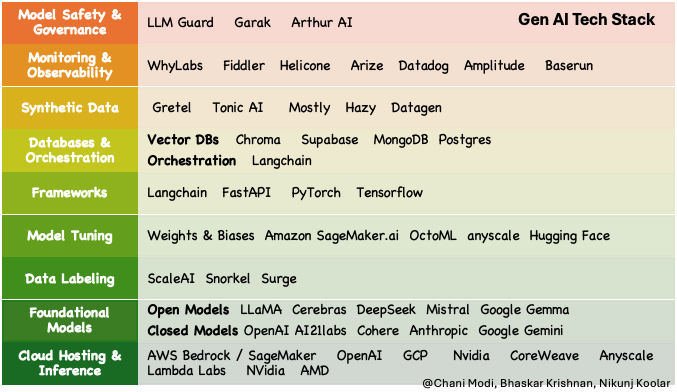Co-authors: Bhaskar Krishnan, Nikunj Koolar
Generative AI is no longer just a research curiosity—it’s becoming the operating system of modern product development. For product managers, fluency with the Gen AI tech stack is quickly shifting from nice-to-have to non-negotiable. PMs who can rapidly prototype, collaborate with engineers, and deploy AI-driven features will lead the next wave of innovation.
This article unpacks the core layers of the Gen AI ecosystem and highlights the skills, tools, and collaboration models that allow PMs to go from concept to prototype with speed and confidence.
The Gen AI Tech Stack: A PM’s Primer
The AI ecosystem has matured into distinct layers. PMs don’t need to master every detail, but understanding the landscape helps set direction, frame trade-offs, and collaborate effectively.
Foundational Models: From open-source (LLaMA, Mistral, DeepSeek, Gemma) to closed APIs (GPT, Claude, Gemini).
Frameworks & Orchestration: LangChain, PyTorch, TensorFlow, and vector databases like Chroma that connect models to real workflows.
Data & Labeling: Scale AI, Snorkel, Surge for annotations; Gretel, Tonic, and Hazy for synthetic data.
Tuning & Monitoring: Weights & Biases, SageMaker, OctoML, WhyLabs, Fiddler, Arize to ensure reliability and performance.
Cloud & Inference: AWS Bedrock, OpenAI API, Google Cloud, Nvidia, CoreWeave, Lambda Labs to scale deployments.
Governance & Safety: LLM Guard, Garak, Arthur AI for trust, compliance, and safe rollout.
For PMs, the value isn’t memorizing vendors—it’s knowing what’s possible and which trade-offs matter at each layer.
From Models to Agents: The New Building Blocks
The real shift isn’t just bigger models—it’s how they’re being packaged into agents. These purpose-built assistants can reason, use tools, and automate tasks. Broadly, they fall into four buckets:
General-purpose assistants – built-in chatbots for quick research or automation.
Workflow builders – drag-and-drop platforms that allow non-engineers to prototype complex flows.
Developer platforms – deeper toolkits for engineers to customize agents.
Specialized apps – single-purpose agents (e.g., coding, market research, customer service).
For PMs, the takeaway is clear: sometimes the fastest way to innovate is stitching together existing agents rather than building from scratch.
Rapid Prototyping: A PM’s Competitive Edge
Nvidia’s Jensen Huang has called AI “the most profound technology mankind has ever created.” That scale of change means PMs can’t wait for long roadmaps—they need to test ideas fast.
Practical approaches include:
Using playgrounds (OpenAI, Claude) for instant experimentation.
Browser-based coding tools (Cursor, Replit, Bolt, Lovable) for quick demos.
Working side by side with engineers instead of handing off specs.
This “fail fast, learn fast” culture is what separates teams who talk about AI from those who ship it.
Essential Technical Fluency for PMs
You don’t need to be an engineer, but you can’t remain a tourist either. PMs should build lightweight skills to bridge vision and execution:
Write small Python scripts.
Connect REST APIs to product data.
Manipulate CSVs with Pandas.
Scrape web data for insights.
This fluency builds trust with technical peers and keeps iteration cycles moving.
Collaboration & Culture in the AI Era
The future of product development isn’t PMs dictating specs—it’s co-creation. Airbnb’s Brian Chesky noted: “There’s a new generation of designers and engineers working side-by-side, not one telling the other what to do.”
At Shopify, leadership has gone further: “Teams must prove why a human hire is needed if AI could do the job”.
That signals a cultural shift.
AI literacy is now a baseline expectation.
Takeaway
AI is moving too fast for passive observers. Product managers who master rapid prototyping, adopt lightweight technical skills, and understand the AI stack will lead the next era of digital products.
The question isn’t whether you’ll use AI. It’s whether you’ll lead with it.
Appendix: The Broader Tech Stack
For PMs who want to dive deeper, here’s a richer breakdown of the ecosystem:
👉 You don’t need to evaluate every vendor. But knowing the categories equips you to ask sharper questions, frame trade-offs, and steer AI conversations with authority.


